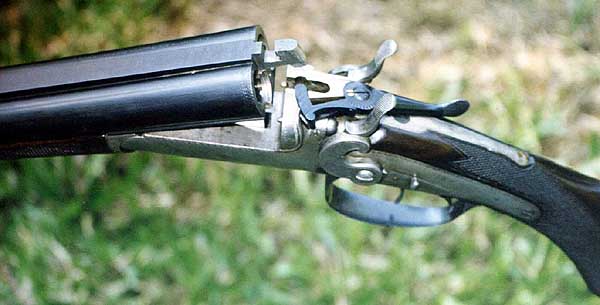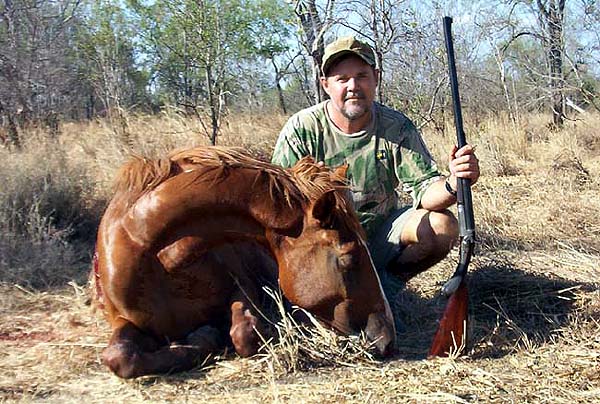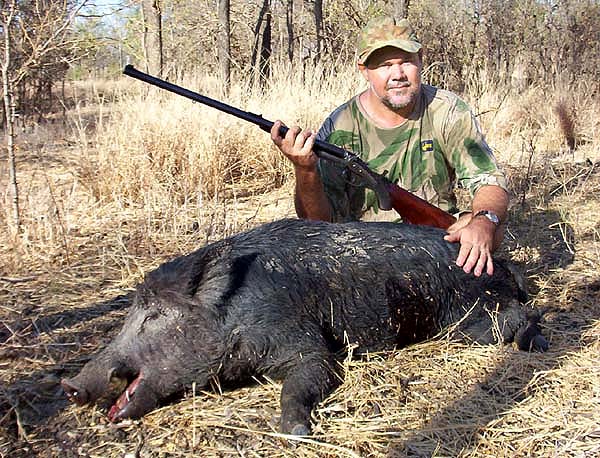There it was again, pinned on the notice board at our local shooting range. As I casually scanned down the now-familiar print-out, I noticed a certain Tolley black-powder double rifle had found its way back onto the list of firearms for sale. When this private listing had first appeared nearly a year ago, my inquiries brought the response that there had been plenty of interest, and negotiations were under-way to sell the Tolley into the US. I had missed out. Now my suspicions were aroused! Something about this particular gun was obviously undesirable: what was it, and could I fix it or live with it?
Next afternoon the slim little black-powder double was in my hands, the subject of intense scrutiny. Dating the gun was anything but straightforward, as the collection of features by which age can normally be determined proved somewhat enigmatic. It was fitted with unusual flat circular hammers and mushroom strikers, which tended to indicate an early date of manufacture. The rounded action body boldly engraved with the black-powder charge in drams straight down the side of the bar further supported this assumption. These features contrasted strongly with the fluid-steel barrels, and the locks although back-actioned were rebounding and bolted. Purdey-style under-bolts activated by an elaborate top-lever capped off this curious mixture of old and new from the Golden Years of British double-gun development.

As far as top-levers go, the gun displayed perhaps the most unusual I had ever encountered. A long hook-shaped projection of the lever engaged a deep channel cut in the top of a huge rib extension. Although the affair looked rather clumsy when open it was clearly a very strong and effective third bite when closed. A search of the relevant literature revealed that this unusual closure was covered by British Patent No. 461 awarded to Henry Tolley in 1877. The catalogues of J. & W. Tolley at the time referred to the invention as Tolley’s “Giant Grip”. This particular third fastener gained early fame by having the good fortune to be illustrated in “The Modern Sportsman’s Gun and Rifle” by ‘Stonehenge’ in the early 1880s. Modern treatments are to be found in “The British Shotgun” by Crudgington & Baker, and a Boothroyd article in Vol. 33 of ‘Guns Review’ magazine.

So what was there about this marvellous firearm which had turned away all previous prospective buyers? Sure enough, a number of fairly overt cosmetic faults needed serious consideration before making an offer on the gun. Firstly, it had been heavily ‘refinished’ at some stage in its past, with little regard for the correct restoration procedures befitting a vintage double. Although the re-blacking of barrels, top-lever, and trigger-guard was very well executed, the action-bar had been wire-brushed at some stage, and buffed to a high polish. A heavy coating of Tru-oil had left the stock with a garish glassy finish topped off with a Pachmayer recoil pad.
From a technical viewpoint, the worst was yet to come! The gun had been tightened by dove-tailing a new face onto the front of the forward lump and re-cutting the hook. Although this had been done very well, the replacement hinge-pin had been simply filed off flush with the action-bar, and never re-engraved. At least the gun was now tight! Thankfully the bores were bright and shiny, showing only modest wear to the rifling and very few marks, however one chamber contained small patches of pitting and both looked strangely oversized for the .500/.450 3 ¼ Magnum Express cartridge. Perhaps they had been badly neglected at some stage, and heavily lapped to repair the damage. Now they looked more like .450 No.2 chambers!
I also noticed that the extractor did not push out as far as it should, and occasionally when closing the action, the extractor plate bumped the firing pins and made closing difficult. Closer examination revealed that the extractor rod had been deliberately shortened, probably to prevent serious damage to the firing pin noses. Most similar doubles I have examined had small bevels on the extractor plate to gently push back the protruding firing pins on closing, however they were absent on this particular gun. Was the extractor assembly a replacement? In any case, filing in a pair of small chamfers would have been a more logical solution than permanently reducing the length of extraction.
A growing weight of adversity was stacking up against the acquisition of this firearm, however the asking price was gradually moving in the opposite direction so I decided to subject the little double to the ultimate selection criterion: would it shoot?! Fortunately the owner consented to a range session, so the necks of some old .470 cases were pushed down in a carbide .455 Webley die, and a batch of light-nitro loads assembled using Graeme Wright’s ‘recipe book’ as a guide. A 300-grain Taipan .458 was seated over 72 grains of AR2208 (Varget), with a couple of saddle-felt wads to take up the air-space.
To my absolute delight, the Tolley proved to be extremely well-mannered at the shooting bench. Left-barrel groups were nothing short of spectacular, with five shots into 1 ¼ inches at 50 yards all day, and the right barrel which had obviously sustained heavier use could still manage 1 ½ x 2 ½ inch groups with the open express sights. The left-barrel groups were completely contained within the right-barrel groups, and a few pairs of shots at 100 yards confirmed that it was still perfectly regulated at that distance. I was now going to have to give this some serious thought!
Ultimately I am a believer in fine shooting qualities above (almost) all else, especially when most of the cosmetic faults and many of the mechanical flaws are easily rectified. Eventually I brokered a deal which undoubtedly favoured the previous owner, however I was now the proud custodian of a very interesting double rifle as well as a proven shooter! With 350 grain Woodleighs loaded to 1950 fps, there was no doubt that the rifle would be buffalo-capable with care, and should be just about perfect for large Northern Territory boars. I couldn’t wait to get the Tolley out into the hunting field, though several seasons would pass before circumstances permitted a proper test of the firearm’s merits.
I did carry the rifle on a couple of short walks not far from the edge of town, however no opportunities presented themselves at the time. A number of more recent purchases then needed a workout, and one in particular became a firm favourite for hunting at the exclusion of all others in my gunsafe. In the meantime, I had at least managed to bevel the extractor-plate to protect the firing pins, and took the opportunity to have the hinge-pin ends re-engraved when Lee Davidson visited Darwin for a ‘working holiday’. Turns out he had been a previous owner of this very rifle many years ago! The world of vintage double-guns is indeed small! Eventually a serious hunt was planned to include the Tolley, and although I had not yet completed all the restoration and repairs it was certainly well up to the job at hand.
The short drive from Matt Graham’s Safari Camp to the big swamp on the Roper River traverses black-soil gilgai country, and as we bounced our way through the shallow depressions a mob of feral horses was encountered returning from an afternoon drink. By the time I had uncased the Tolley and plonked in a pair of those long gleaming cartridges, the horses’ path had brought them to within about 60 yards of the track. A convenient ‘gutta-percha’ sapling was used to steady the forward hand, and a 350-grain blue-nose Woodleigh was on its way towards the lead mare’s ribcage.
At the shot, the entire mob bolted but within a few seconds the mare had faltered and a tell-tale cloud of dust and flailing hooves confirmed that she was down. The bonded-core projectile had completely penetrated the horse’s chest, and judging by the amount of lung tissue scattered about it had obviously expanded perfectly. I was elated: this was my first shot on game with the Tolley, and the results had certainly vindicated my faith in both the rifle and the cartridge. Not bad, considering each is well over 100 years old!

An hour later I had accounted for a medium-sized sow on the run, and found myself knee-deep in mud approaching a grassy area out in the swamp still with some daylight up my sleeve. About 40 pigs were in sight, however all appeared to be sows, young boars, and half-grown suckers. I was about to move on when a commotion at the edge of the paperbarks caught my attention. A good boar had emerged from the forest and was making a nuisance of himself amongst the sows. Eventually he found one to his liking, so while his attention was diverted I put in a stalk across the open ground to a dead-fall covered in paragrass. The stalk had required me to pass within 10 yards of the nearest pigs! Fortunately the light breeze held and I was able to peep around the deadfall and align the Tolley’s sights on the unsuspecting boar’s shoulder.
A loud ‘boom’ echoed across the grassy flat. Instantly all heads were up, followed by a mad stampede for the safety of the paperbarks! ….including my boar! Had I missed? Plodding across the now-empty clearing, I soon picked up a copious blood-trail, and found the quarry just inside the tree-line. Although down, he still showed signs of life so the contents of the second barrel was administered between his shoulder-blades to finalise the encounter. Unfortunately my camera had been left with the other party so the event went unrecorded, but I was still pretty happy with the performance of this marvellous vintage double!
The sun was now dropping below the horizon, so a course was plotted along a creek channel back towards the vehicle. After crossing a muddy gutter, I was confronted with yet another reasonable boar which simply materialised out of the gloom! Fortunately he stood looking back over his shoulder for those critical few seconds needed to get the hammers back and the front bead on his ribs. Upon receiving the bullet, he took off at a dead run but piled up after passing through a narrow belt of coolibah regrowth. Again, the bonded-core projectile had passed completely through the animal’s chest: it was obvious there were not going to be many successful bullet recoveries with these Woodleigh Weldcores! By that stage the light was too far gone for a decent photograph, however the vehicle track was not far away so the boar was propped up for an early morning photo next day.

Before packing for home, I reflected on my choice to include the .450 double express on this trip to the Roper country. In the end, the decision had been easy. I am badly afflicted with a deep desire to restore vintage rifles and return them once again to the purpose for which they were designed and built in the Old Country so long ago: hunting wild game in far-off lands! More than a century later, the little Tolley was certainly still equal to the task!